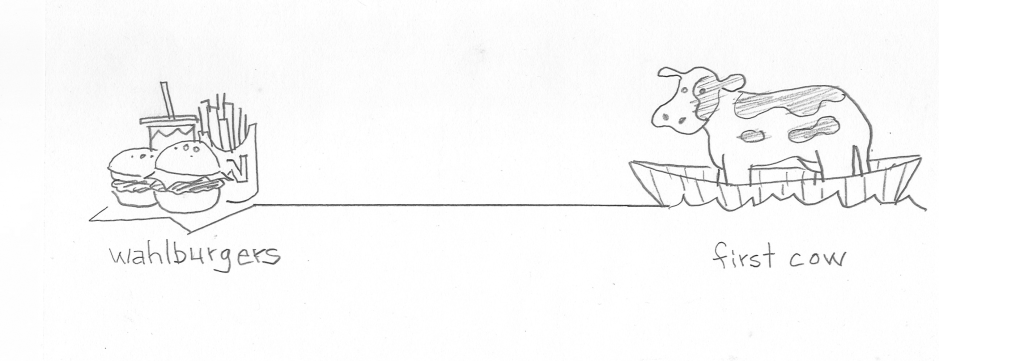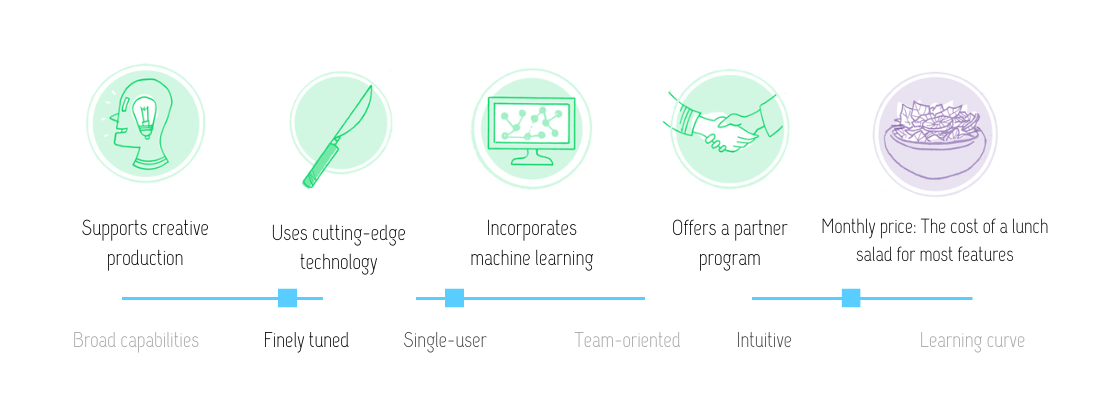Content powers many businesses, but decision-making about content strategy is rarely elevated to the leadership level. These five continua will directly connect content strategy decisions with budget fluctuations and tangible results.
It’s Aquarius season, which means we indulge in some big thinking about technology and community. Since Aquarius is my rising sign, I’m all about beating the midwinter blues with some rational creativity. This year there is no real cold to be had (it's warm, too warm), but my galaxy brain persists nevertheless.
Earlier this month, we revisited our definition of content strategy to align it with the expectations of the collaborative, networked 21st century workplace and content business. Here’s that definition, in case you don’t want to click through:
Content strategy defines why, how, where, and for whom a company creates content. It comprises the activities that connect business goals with audience (aka consumer, customer, user, or client) needs, identifies content’s purpose in an organization, and specifies the conditions that make content successful.
Today, we’ll outline some new dimensions for connected purpose with outcomes, made apparent by changes in human behavior and business structures over the past 15 years. Because content strategy is not just about setting up style and governance documentation or getting creative in a brainstorming meeting. It’s not just the fun stuff. Instead, it’s about having a clear position and vision for how content functions in an organization and works to achieve business goals, while meeting user/client/customer/audience needs.
In digital strategy and measurement, “dimensions” describe what you’re measuring. Y’know, like height and width or space and time. Lots of content strategists, myself included, love a two-dimensional evaluative scale—an Approval Matrix, a Magic Quadrant, an effort versus impact discussion. But very few decisions can be made on two dimensions alone, especially in complex organizations. So, hey, let’s expand our strategic minds.
Longtime readers of The Content Technologist will know that I’m a huge fan of a continuum or, if needed, a Likert scale. The continuum* tool makes quantifying abstract concepts a little easier for word people, while still creating airspace for a flexible interpretation of guidelines across an organization. It’s more amenable to the collaboration that powers strong, content-savvy businesses than strict sets of rules.

The Wahlburgers–First Cow continuum is, of course, the greatest cultural continuum.

Continua are easy to visualize, can work together to inform decision-making, and don’t have to be mutually exclusive. If you must, these five continua can be visualized together on a spider graph (but of all the graphs I find the spider to be far less exciting and compelling than pretty much every other type of graph). Mostly, they are helpful as decision-making tools for understanding reality versus ideals, an agreed-upon line to point back to every time that decision is questioned or doesn’t result in outcomes as expected.
*“Continuum” is immensely pleasurable to say, read, and write. Two u’s together? But not a “w”? How droll! And the plural is “continua,” which sounds like a sci-fi action hero. Lots of the work we do in content strategy is kinda tedious, but using the word “continuum” harnesses a word geek’s greatest weapon: the power of vocabulary.
How and when to introduce new content strategy dimensions
After you’ve finished all your content strategy research and deliverables — interviews, keyword research, social listening, customer interviews, persona development, SWOT analysis, etc. — it’s time to make some actionable, consequential decisions informed by your hard work.
The below dimensions are designed to be workshopped and discussed at a macro level, in the same way you’d chat with stakeholders about mood boards in a brand identity meeting or budgets in annual planning. They are intended to be discussion points for the executive team or department leadership to collaborate with content leadership, with functional outcomes that are woven into how content is administered, produced, distributed, styled, and measured.
The below dimensions address business needs often ignored or unacknowledged in the content development process, while introducing longstanding literary analysis concepts to brand-level content strategy work. They are meant to address—and make stakeholders understand the impact—that an audience perceives a brand as an entity, not individual departments of public relations, advertising, marketing, customer service, and content publishing. Because these dimensions are created on a continuum, most brands will fall somewhere in between, but it’s helpful for planning to know the ratio of how much whimsy or how much outsourced content the brand is willing to accept.
A discussion with leadership involving these dimensions and tying them to business goals also helps counteract the “I can make that” attitude. Common especially in tech-oriented organizations, this attitude is what happens when a hypothetical CFO or a bad date visits an art museum, points at a Rothko, and says, “I could make that.” It’s one of my least favorite human attitudes, full of hubris and dismissiveness. If someone who isn't an artist thinks they could paint a Rothko, it’s likely they think your job is disposable. These content strategy continua are intended to display that we can fuse content with work, that an insistence on intentionality is directly connected to business outcomes.
A few content strategy continua for consideration at your next leadership retreat
These dimensions are still conceptual, but they are based on my experience across clients in many industries and the most common pain points that content professionals and their employers encounter.
The continua aren’t mutually exclusive of each other, but they are designed to set an ideal that matches audience needs with business goals. They’re developed to help businesses think about the true costs and trade-offs of content, remembering that ideals are often sacrificed when faced with the realities of budgets.
Content strategist leading this discussion should be equipped to talk through the ups and downs of each side of the continuum from a business perspective, steering leaders away generic “storytelling” and “blog” language and toward specific decisions that have a high business impact.
Verisimilitude versus whimsy
How much magical realism will your brand indulge in? Is your content an escape from reality or firmly grounded in being practical and true-to-life? How much hard news do you balance with aspirational content? Will surprise and delight be your bread and butter, or will your brand prioritize practical connections from matter-of-fact content?
Do you lean more into inspiration or into how-tos? Have hard-lined editorial policies on your website? Do you ever get cute? How does this decision affect how you position and design advertising and promotional content and documentation alike?
Drama versus service
Does your brand embrace storytelling and the writerly concept of “raising the stakes”? Do you participate in the “discourse,” spitting out hot takes and taking a stand when your values are in question? Do you get behind heroes and villains or use any of the concepts from Aristotle’s Poetics? Do you post so often that you can’t avoid entanglement? What does taking a chance with content look like for your brand? Do you post so often that you can’t avoid drama? Do you respond immediately and publicly to customer complaint social media posts?
Or, conversely, do you eschew all narrative for a fully functional and accessible audience experience? Do you prioritize fixing errors over creating new stories? Assuaging user needs over attracting new audiences? Reducing churn over winning at Cannes? How does your brand balance the need for both, and how does that play out in your content?
In-house versus outsourced
Where does your content come from? Do the ideas in your content and the research you need to produce it—whether it’s customer service needs or social media posts—derive inside the experienced voices of your brand (subject matter experts or SMEs), or does your company look to outside experts and sources to provide the backbone of content? Do you produce your own research? If you do look to outsourced expertise, are you just quoting old tweets and regurgitating other websites, or are you conducting original interviews with experts or looking at scientific journals?
This dimension applies not only to the ideas in a brand’s published content but also to internal hiring and outsourcing. Where does your brand use in-house expertise, and what do you trust to be outsourced to another vendor or agency? What is the ideal on the continuum, and how does it benefit both internal operations and your audience?
Programmatic versus crafted
Even though the entire discipline of ‘prompt engineering’ was clearly concocted by people who avoid the ‘whimsy’ side of the continuum, I see many brilliant uses for generative AI. I also see just as many opportunities to dodge good work and avoid responsibility.
In the age of generative AI, we can automate many aspects of the content production, administration, and distribution process throughout an organization. In the business of content, we’re not going to get away from it.
When content is programmatic, are you using machine learning and generative AI, which are far more error-prone than straightforward “if this, then that” programs? If you are using more error-prone methods, are you adding in human layers of editorial review? If you’re going the straight marketing drip automation route, who is responsible for orchestrating, modeling, and evaluating outcomes?
Responsible organizations should acknowledge, at the brand content strategy level, where the human touch appears, in ideal scenarios and in resource-strapped circumstances. Where does the automation come in, especially in the production and distribution stages? How do your audiences perceive this automation, and how does that impact the business? And conversely, what gets the most human touch and review? Who is responsible for deciding which content is automated—and which roles are impacted by automation—at a macro-organizational level? Is it your CTO, CMO, or your CEO? Even if you’re not in the room making this decision, it’s helpful to understand how your leadership considers this question (if they’re willing to share).
Unique versus conventional
When asked about content, leaders often say they want authenticity, mostly because they heard “authenticity” was trending (it always is). For audiences, “authenticity” can be anything from extremism in the name of “real talk,” prank videos, AdBusters-style parodies, or the lady who yells on Instagram about why everyone else is doing laundry all wrong. When audiences say “authentic,” they often mean “amateur” or “individual.” When company stakeholders say “authentic,” they most often mean “unconventional.” And when they look at the results from the first unconventional experiment, they creep back to “slightly different than what we’ve already produced but not really.”
The uniqueness versus conventional continuum positions content strategy to preempt the authenticity request while acknowledging the need for creativity to stimulate interest. By setting realistic expectations for understanding how unique our content in its different forms can be and how that impacts both customer experience (CX) and business outcomes. Conventional is expected but comfortable. Unique is attention-getting but risky. Where on the continuum will your content fall?
Product versus toolkit
Finally, we get to the money question: how is content expected to impact your bottom line? Is content a source of revenue in your organization, and will you be selling subscriptions, tickets, and/or advertisements? Are you experimenting with paid content or paywalled research?
Or, are you sending thought leaders to conferences to spread the word about your business, hoping they bring back a client or two, or at least a few good leads? Ultimately, when does your content generate revenue and when does it generate leads or audience connection?
Notice that I didn’t use “awareness-generating” here, mostly because keeping content at the “awareness” level is often the reason it’s devalued at many organizations. I’d argue that even benign informational, educational, or customer support content has a lead-generating or indirect revenue-generating capacity. It’s the content strategist’s job to point out how the content affects the business model.
It’s also worth mentioning: Content strategy is never, ever just words. It’s not just writing and visuals, or video and channel distribution. It’s about considering the impact of business decisions on communication with an audience, and the interplay of how an audience and business respond with each other. All content types are on the table for all above dimensions, as are all functions that content touches, connecting sales collateral with customer service complaints.
Outcomes of multidimensional thinking about content strategy
Understanding where your business leaders and content leaders align informs a whole slew of decisions for your company's content, including content types; levels of investment in marketing, advertising, product, and customer service content; vendor selection; channel selection; and publication pace. With a fairly clear understanding of how their brand prioritizes each dimension, content strategists can set key performance indicators (KPIs) and goals to accommodate the dimensional ideal.
For example,
- A business that desires a high degree of verisimilitude should probably lean more toward photography and testimonials than toward AI-generated videos and graphics. If that content strategy also dictates the content should be a crafted product, established outsourced photographers will probably be a worthwhile investment. If we’re aiming for toolkit support and programmatic content with an in-house tilt, a brand library of multiuse stock photography will likely do the trick.
- Cultural institutions I’ve worked with in the past tend to embrace service with a dash of drama or two parts verisimilitude to one part whimsy in their existing content strategies, but don’t necessarily tie those outcomes to the split of how their content directly sustains their audience as both a product and a toolkit. The above dimensions can prompt that discussion directly, especially since experiential content has regained popularity.
- Whimsical service content strategies are surprisingly common, especially in Millennial-oriented direct-to-consumer (D2C) brands. The Instagram laundry lady definitely falls under whimsical service alongside Disney, as do all the heavily printed boxes that reveal a surprise message upon opening. But while the microcopy may be human-crafted, the content distribution and audience experience is ultimately heavily programmatic, with a churn of social posts that match terms discovered in keyword research, with most of the work outsourced to freelancers, influencers, and agencies.
- A business may forget about all its audience research and decide to outsource its very conventional, service-oriented, programmatic content with a high degree of verisimilitude. In practice, this business will likely find that approach alienates the audience for its existing product, who no longer receives the perceived value it once had from, say, its favorite sports magazine. When the strategic ideals don’t align with actual, real-world outcomes, significant adjustment in strategy is required to meet the audience needs.
How will these continua work in practice? We’ll see! I’m mapping outcomes and experimenting with the continuum approach this year, and I’d love to hear your feedback about these ideas. Do more dimensions solve problems or just make things more complicated?
Hand-picked related content







